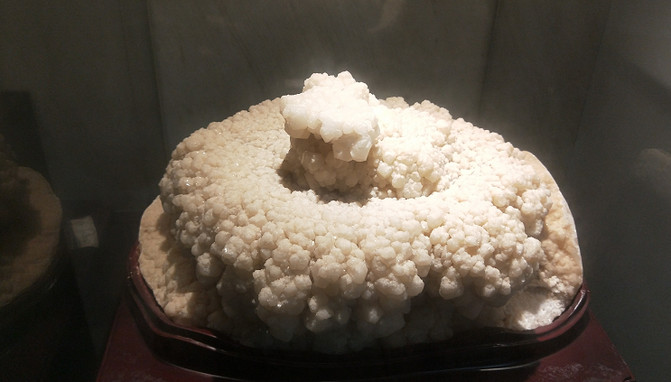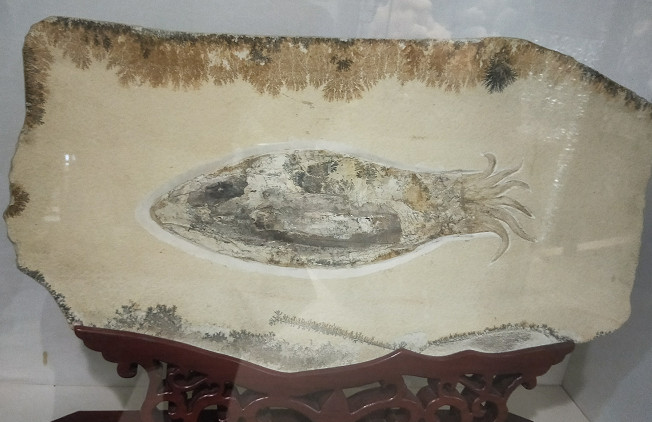Xishan Geological Museum, admire the strange rocks of Taihu Lake-Suzhou 3rd (7)
★ Tourist location: Xishan Geological Museum in Xishan Misty Peak Scenic Area, Suzhou
Although the Geological Museum is also part of the Miaomiao Peak Scenic Area, it is actually outside the scenic area. It takes 15 to 20 minutes to walk by the scenic area bus. You can enter for free starting from 9 o'clock.

Walking into the door, you will find a purely handmade wood carving work of "Ten Everything Great Ruyi", made of rosewood. However, this wood carving work does not use the most precious Hainan huanghuali, but fragrant pear, also known as bird's foot rosewood. In recent years, due to excessive logging of Huanghua pears and close to exhaustion, the color, texture, density and aroma of Xianghua pears are not much different from those of Hainan Huanghua pears, and they have gradually become more likely to replace Huanghua pears.

This work is about four meters long. The raw material comes from the Lancang River and Mekong River Basin. It has a history of more than 2,000 years. Some of the materials are carbonized because of their age. The work is carved from a whole tree without any splicing. The so-called Shiquan refers to the five plants: cloud pine, gourd, flat peach, ganoderma lucidum, and peony, and the five animals: dragon turtle, cloud crane, bat, yellow dragon, and phoenix.

The side hall displays siliceous wood, and several pieces of jade have obvious texture. Many of the original stones are taken from the West Hills of Taihu Lake, the most famous of which is Taihu Lake Stone. The four famous stone stones in ancient China are Yingshi, Lingbi Stone, Kunshi Stone and Taihu Stone. The four famous stones in the south of the Yangtze River, Ruiyunfeng, Guanyunfeng and YuLinglong, are Taihu Stone.

The exhibition hall displays some rocks produced in Suzhou, such as shale stone, volcanic stone, sandstone, strange painting stone, coal gangue, etc., as well as some common ores, such as chalcopyrite, etc., which are not very outstanding in appearance.

The gemstone ores displayed on the second floor of the museum are much more beautiful, including common calcite, malachite, fluorite, turquoise, aquamarine... These ores are produced from all over the world. A hair crystal made in Brazil is relatively large and has obvious hair. Although the color is not bright enough, it is still very beautiful.

There is a table of complete works of Manchu and Han Dynasty made of stone that attracted the attention of many people. From a distance, it is still very realistic. Fortunately, we came a little early and didn't feel hungry after breakfast, otherwise we might have been tempted.

Among the three major types of rocks: igneous rock, sedimentary rock and metamorphic rock, due to their different compositions, structures and formation history, their shapes, colors, grains, quality and sound have different characteristics. With a little artistic processing, they have become Ornamental stones. There are not many precious gems in the museum, but there are quite a few ornamental rocks. Among them, Moorite has the softest lines, and stalactites are the most changeable. Sometimes it can even be fake to coral. At first glance, it really looks like coral!

Stalactites have the most abundant forms and can be described as diverse. There is a stone in the shape of a lofty mountain, which is simply a landscape bonsai.

Amethyst caves and cornucopia are not uncommon. Perhaps because of the light, it seems that the amethyst does not shine too brightly. However, the cornucopia has a perfect shape, with a slightly thicker wall and a cover.

There is a desert rose decoration that is also very large. This kind of stone has beautiful and strange shapes. In fact, its main cause is water-containing calcium sulfate, which is what we usually call gypsum. Because multiple plate-like crystals intersect, clusters of rose shapes are formed, which is very beautiful.
The "stone gall" is also very strange. When viewed from the front, it looks like a large sea urchin. Its texture also clearly surrounds it in a perfect circle, with a gray-black spot left in the middle.

Stibnite is also a relatively strange crystal. They are pure black and stretch out in clusters. They look disorganized, like short rods radiating outward.

Malachite has a beautiful and deep green color. When placed on a peacock shaped wooden frame, it really looks like a peacock's open screen.
Fossils are completely different as objects for viewing and scientific research. Generally speaking, we can taste them from eight aspects: truth, rare, strange, shape, spirit, color, quality and quantity. However, for laymen like us, it's really hard to see. Nowadays, the splicing technology is in a state of perfection, and ordinary people really don't have the ability to distinguish between babies and ordinary people.

There is a crinoid painting that is very large in scale and has clear fossil patterns. At first glance, it does not seem real, but seems to be drawn.

The fossil of Parrot's beak surprised me. Although I have always known that Parrot's beak can only be regarded as a small dinosaur, I never expected it to be so small!

There are also the more common ammonites, squid, trilobites, and dinosaur eggs, which do not look very good. However, there is one colorful ammonite that is not common.

Common silicified jade is a deep and light brown, which is basically the same color as the wood. However, there is a piece of siliconized jade in the display cabinet that has not only been made of jade, but also the color is emerald green and white, which is very beautiful.

Next to the museum is Taihu Xishan National Geopark. The tanks in the pond are all empty. I think water lilies will bloom in summer. There is a rectangular conference room in the middle of the pond. Although it is not open, it looks beautiful through the glass and in summer.

The wax plum blossoms in front of the museum are in full bloom, and it is now in its full bloom. Although the tree is not tall, it is unambiguous when it blooms.

We regret it a little bit from the path on one side to climb the back mountain of Misty Peak. If I had known that I would climb down from the back when I reached Misty Peak, I would have been able to visit the stele corridor along the way. Sometimes when you want to save trouble, you will actually miss a lot of beautiful scenery!
















Previous Article:Zhenze, a private attraction in Jiangnan Water Town, has never been to it. It is open for free and parking is free.
Next Article:East Taihu Lake, One Dike and Double Scenery Ecological Park-Wujiang 5th (6)
